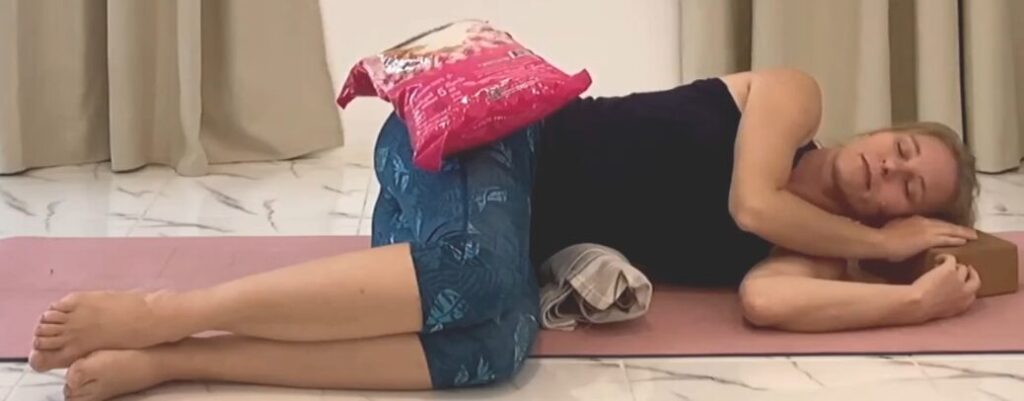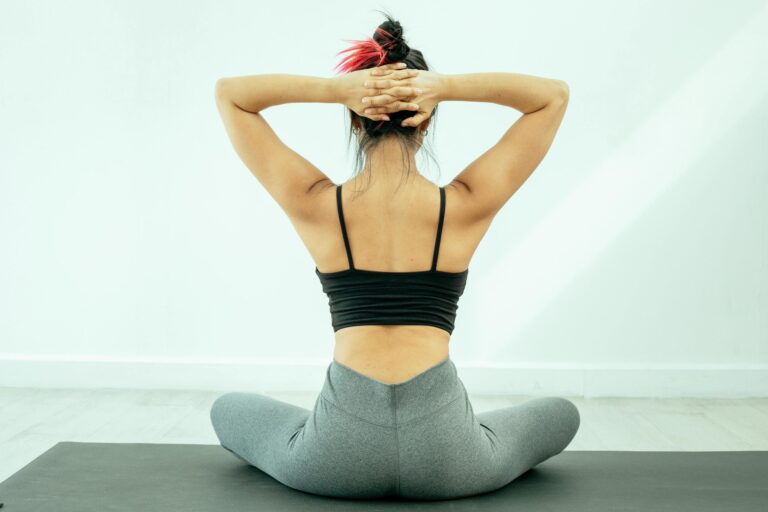Understanding pelvic floor weakness: Why pelvic mobility is crucial
In yoga practice, the pelvic floor is often treated as something that "just needs to be strengthened". But what if the cause of pelvic floor weakness lies somewhere else entirely? Namely in the Bone structures of the pelvis itself.
In this article you will find out why Lack of mobility in the pelvis and a Chronic away rotation are often the actual causes of weakened and tense pelvic floor muscles - and how you can counteract this with targeted inward rotation.
Pelvic floor weakness - not just a question of muscles
Many sufferers suffer from a seemingly paradoxical combination: the pelvic floor simultaneously feels tense and powerless on. The problem often lies not only in the muscles themselves, but in the limited mobility of the bony pelvic structure.
You can illustrate this with other parts of the body: When we hold our arm straight, we can build up less strength in the upper arm muscles compared to when we bend the arm.
From a biomechanical point of view, a healthy pelvic floor depends on the pelvic bones being mobile - especially in relation to Inward and outward rotation (also internal and external rotation).
But for most adults, the pelvis is chronically rotated away from homeoften on both sides. This means:
- The pelvis is structurally blocked in an open position.
- The pelvic floor muscles can can no longer be fully extended or shortened.
- This means that no real power development can take place.
A muscle that cannot go through its full amplitude of movement can do not become strong - no matter how many "pelvic floor exercises" you do.
Why an outward rotation blocks the pelvis
In outward rotation, the pelvic blades open to the side and the sacroiliac joint is narrowed. This posture is favored by tight hip flexors, tense gluteal muscles and too little reactivity in the muscles of the back of the thighs and hips. The result:
- The Pelvic bones fix themselves in an externally rotated position.
- The pelvic floor muscles are restricted in their movement.
- A feeling of Tension with simultaneous instability.
- The pelvis leaves its neutral position and a hollow back or rounded back is encouraged.
This dysfunctional combination can manifest itself as:
- Incontinence
- Pain during sexual intercourse
- Pain in the lower back
- a strong hollow back or flattened lower back
- an unstable gait pattern
- Hypermobility with typical "hip opening asanas"
The solution: Movement in the opposite direction - inward rotation
In order to really activate the pelvic floor muscles, the Mobility of the pelvic bones be restored. And this happens by bringing the body into a position that Inward rotation promotes.
So instead of continuing to strengthen the outwardly rotated posture, work specifically with a gentle, passive posture that helps your pelvis to relax. reorganize.
Exercise: Inward rotation through passive compression - how it works
This exercise is not strenuous, but calming. It helps you to relieve the bone structure and promote internal rotation by applying gentle pressure to the pelvis.
What you need:
- A rolled-up blanket, a firm towel or small pillow
- A pillow for your head
- A mat (e.g. your yoga mat)
- A weight: e.g. a large bag of rice, a sandbag or even a filled carrier bag (the heavier the better - at least 10-20 kg is ideal, but you can also ask another person to sit on your pool)
This is how it works:
- Come into the lateral position - to your left side of the body and rest your head on a pillow so that your spine remains neutral.
- Place the Blanket roll under your stomachso that it reaches from the lower ribcage to the pelvis. It should gently support the abdomen and ensure that the spine remains in line.
- Bend your legs at a 90° angle (hips and knees). If this is uncomfortable, bring them a little lower.
- Align your pelvic bones straight on top of each otherThe right pelvis should lie exactly over the left - if this is uncomfortable, the right side may tilt slightly forward.
- Place the weight on your upper (right) pelvis.
→ Important: Don't be afraid of weight. A healthy bone structure can support 80 kg and more. You should only be careful with diseases such as osteoporosis, etc. - Stay 10-15 minutes in this position. Breathe calmly. Let your weight push you down.

What happens in the process?
The compression brings your pelvic bones closer together at the front of the pelvis and thus opens up space in the sacroiliac joints. This leads to a gentle inward rotation and gives the pelvic floor space to open and close again. The deep muscles are thus reactivatedwithout you having to actively control them.
You can find an explanation and instructions in video form on my YouTube channel:
Why this exercise is so effective
- Biomechanically sound: It corrects structural misalignments instead of just treating symptoms.
- Passive and relaxing: You don't have to "work", but calm your central nervous system - an absolute must to reduce muscle tension.
- Effective in the long term: Daily use can permanently reorganize the pelvis - with positive effects for the pelvic floor, breathing, posture and your body awareness.
Conclusion: More connection through more mobility
A functioning pelvic floor needs more than just strength. It needs Mobility in the pelvis - especially in the form of Inward rotation. By working specifically on making your pelvic bones flexible again, you enable your pelvic floor to finally return to its original position. full amplitude. The result: less tension, more strength, a new feeling of connection with your pelvic floor and a better feeling during intercourse.
Curious?
In my program "Unlock Your Pelvis" you will learn how to activate your pelvic floor step by step in a functional and biomechanically correct way - without classic Kegel exercises and without pressure to perform. You can find more information here:
For women: https://devaduta-yoga.com/de/kurs/unlock-your-pelvis/
For men: https://devaduta-yoga.com/de/kurs/unlock-your-pelvis-for-men/







